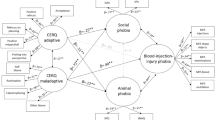Abstract
Thirty-two spider-fearful, 33 blood/injury/injection fearful, and 28 non-fearful individuals (N = 93) participated in dual-task study. Participants were presented with blood, spider, neutral, positive and pseudo-word stimuli while having to also verbally identify numbers as either even or odd. Blood-fearful individuals responded slower than spider and non-fearful individuals. However, there was no interaction of group membership with stimuli type. This study replicates the results of two previous studies that have used a lexical decision task in an effort to differentiate between fearful and non-fearful individuals and found no significant differences between these two groups on this task. These results suggest that the lexical decision task in general may not be sensitive enough to elicit processing differences in non-clinical samples.
Similar content being viewed by others
References
Baldwin, M. W., & Main, K. J. (2001). Social anxiety and the cued activation of relational knowledge. Personality & Social Psychology Bulletin, 27, 1637–1647.
Barlow, D. H., & Liebowitz, M. R. (1995). Specific and social phobias. In H. I. Kaplan, & B. J. Sadock (Eds.), Comprehensive textbook of psychiatry, VI (pp. 1204–1217). Baltimore: Williams & Wilkins.
Chen, E., Levin, M. R., & Craske, M. G. (1996). Effects of state anxiety on selective processing of threatening information. Cognition & Emotion, 10, 225–240.
Christopherson, K. M. & Ferraro, F. R. (2009). Primed lexical decision task in fearful and non-fearful individuals. Journal of Psychology Interdisciplinary and Applied, in press.
Ferraro, F. R. (1995). Aging, Alzheimer’s disease and word recognition: A review of the recent literature. In P. A. Allen, & T. R. Bashore (Eds.), Age differences in word and language processing. Amsterdam: Elsevier Science B.V..
Ferraro, F. R., & Chelminski, I. (1996). Preliminary normative data on the Geriatric Depression Scale-Short Form (GDS-SF) in a young adult sample. Journal of Clinical Psychology, 52, 443–447.
Ferraro, F. R., Christopherson, K. M., & Douglas, J. (2006). Lexical decision task performance in blood-fearful and spider-fearful individuals. Current Psychology: Developmental, Learning, Personality, and Social, 25(2), 132–143.
Kellas, G., Ferraro, F. R., & Simpson, G. (1988). Lexical ambiguity and the time course of resource allocation in word recognition. Journal of Experimental Psychology: Human Perception & Performance, 14, 601–609.
Kindt, M., & Brosschot, J. F. (1998). Cognitive avoidance in phobia. Journal of Psychopathology and Behavioral Assessment, 20, 53–55.
Kindt, M., Brosschot, J. F., & Boiten, F. (1999). High-level cognition in phobics: Abstract anticipatory memory is associated with the attenuation of physiological reactivity to threat. Journal of Anxiety Disorders, 13, 473–489.
Marks, I. M., & Mathews, A. (1979). Brief standard self rating for phobic patients. Behavior Research and Therapy, 17, 263–267.
Öst, L. G. (1985). Mode of acquisition of phobias. Acta Universitatis Uppsaliensis (Abstracts of Uppsala Dissertations from the Faculty of Medicine), 529, 1–45.
Rusted, J., & Dighton, K. (1991). Selective processing of threat-material by spider phobics in a prose recall task. Cognition & Emotion, 5, 123–132.
Sawchuk, C. N., Lohr, J. M., Lee, T. C., & Tolin, D. F. (1999). Exposure to disgust-evoking imagery and information processing biases in blood-injection-injury phobia. Behavior Research & Therapy, 37, 249–257.
Schneider, W. (1988). Micro experimental laboratory: An integrated system for IBM-PC compatibles. Behavior Research Methods, Instruments, and Computers, 20, 206–217.
Siegle, G. J., Ingram, R. E., & Matt, G. E. (2002). Affective interference: An explanation for negative attentional biases in dysphoria? Cognitive Therapy & Research, 26, 73–87.
Spielberger, C. D., Gorsuch, R. L., & Lushene, R. E. (1970). Manual for state-trait anxiety inventory. Palo Alto: Consulting Psychologists Press.
Thorpe, S. J., & Salkovskis, P. M. (1997). Information processing in spider phobics: The Stroop color naming task may indicate strategic but not automatic bias. Behavior Research & Therapy, 35, 131–144.
van den Hout, M., Tenney, M., Hyugens, K., & de Jong, P. (1997). Preconscious processing bias in spider phobia. Behavior Research & Therapy, 35, 29–34.
Waters, H., & Green, M. W. (2003). A demonstration of attentional bias, using a novel dual task paradigm, towards clinically salient material in recovering alcohol abuse patients? Psychological Medicine, 33, 491–498.
Watts, F. N., & Coyle, K. (1992). Recall bias for stimuli and response anxiety words in spider phobics. Anxiety Research, 4, 315–329.
Watts, F. N., & Dagleish, T. (1991). Memory for phobia-related words in spider phobics. Cognition & Emotion, 5, 313–329.
Watts, F. N., & Sharrock, R. (1984). Questionnaire dimensions of spider phobia. Behavior Research & Therapy, 22, 575–580.
Watts, F. N., McKenna, F. P., Sharrock, R., & Trozise, L. (1986). Color naming of phobia-related words. British Journal of Psychology, 77, 97–108.
Wechsler, D. J. (1981). Manual: Wechsler adult intelligence scale—revised. NY: Psychological Corporation.
Wenzel, A., & Holt, C. S. (2004). Situation-specific scripts for threat in two specific phobias. Journal of Psychopathology and Behavioral Assessment, 22(1), 1–21.
Wenzel, A., Zetocha, K., & Ferraro, F. R. (2007). Depth of processing and recall of threat material in fearful and nonfearful individuals. Anxiety, Stress, & Coping: An International Journal, 20, 223–237.
Williams, J. M. G., Watts, F. N., MacLeod, C., & Mathews, A. (1997). Cognitive psychology and emotional disorders (2nd ed.). Chichester: Wiley.
Author information
Authors and Affiliations
Corresponding author
Rights and permissions
About this article
Cite this article
Christopherson, K.M., Ferraro, F.R. Lexical Decision Paradigms do not Differentiate between Fearful and Non-fearful Individuals. Curr Psychol 28, 115–123 (2009). https://doi.org/10.1007/s12144-009-9050-5
Published:
Issue Date:
DOI: https://doi.org/10.1007/s12144-009-9050-5




